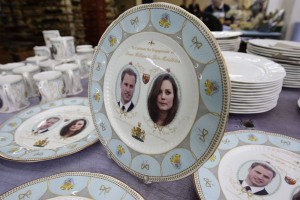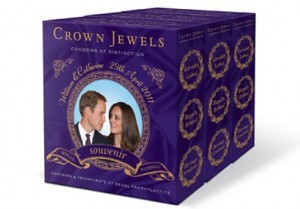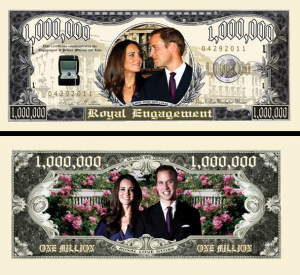A couple weeks ago I reported on the annual “Win-Win-Branding at the Oscars,” where stars’ images benefit from wearing the most beautiful (and expensive) dresses on the market, and designers can cash in on the reputation boost offered through these stars’ endorsements. Now, the next international high-profile event is coming up: the wedding of HRH Prince William of Wales with Kate Middleton in the UK. Public attention regarding this event has been endless – infinite magazine, newspaper, and TV specials, daily discoveries on things like who’s invited and what the cakes will be made of, and – of course – the merchandise.
Although the British royal family is usually not allowed to (literally) ‘put their faces’ or names onto any commercial products, an exception has been made for souvenirs “commemorating” the wedding. Clarence House, Prince Charles’ official residency, has issued a very detailed list of which pictures and crests may be used for any memorabilia, and what kind of characteristics (such as durability and design) any royally branded item must possess so as to be approved by the royal family. And the creativity of manufacturers has been endless – you get your usual ‘Will & Kate’ mugs, plates, posters, stamps, and dolls, but also toilet seats, condom collector’s packs, and copies of Kate’s engagement ring (needless to say, the latter three are only available from sellers outside the UK).
Experts estimate that the sale of such merchandise will generate revenues of approximately $42 million for the British economy, a welcome financial boost given today’s economically challenging times.
However, unlike most merchandise, these ‘Will & Kate’ wedding memorabilia remain unique in that those who actually own and maintain the brand – the British royal family – do not earn a penny in the whole hype. The reasoning behind this is, of course, the fact that the royal family is a representative and a servant to the people of the UK; the people already pay their Queen and her relations for their services with (a lot) of tax money. Still, looking at this number – $42 million total revenue – and at the many UK taxpayers complaining about their money going to an ‘outdated’ monarch, I cannot help but wonder whether in this case one should allow the British royal family to make use of their brand the way companies and organizations do.
If they were allowed to license the use of their names for ‘harmless’ products such as souvenirs, it would generate a whole new source of income for them, and taxpayers could demand to pay less for the monarchy’s maintenance. A very similar development has already taken place a few years ago, when the royal family opened the doors of its many residences to the public so as to generate funds from the entry fees that would allow these properties to be maintained. Most tourists visit places such as Windsor and Buckingham Castle not because they are just nice places to go, but because they are associated with the royal family, i.e. because they have been branded by them.
Thus, it seems that the first step towards using the brand of the British royal family as a source of their income has already been done. Wouldn’t licensing their name(s) for merchandise be the next logical step? Particularly if one were to impose detailed guidelines as to which products could be branded by the royal family and which ones could not?




5 Responses to Branding the British Royal Family